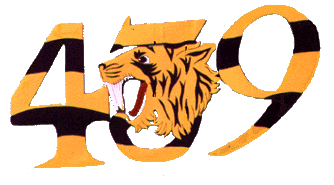|
History
of
 Squadron Squadron
  
Chapter
VII
The Advance to the Rhine
February
- March 1945
As an alternative they attacked a line in eastern Holland,
obtaining at least one cut near Vorden, south east of Zutphen. But even here the
visibility was so poor that most of the bursts could not be seen. No flak was encountered throughout the day's operations.
F/O Adam Saunders had a close call when a tire burst as
he landed from one sortie. The Typhoon swerved off the runway, flipped over on its back and was very badly damaged, but Adam crawled out uninjured. The long rail interdiction campaign ended temporarily with two sorties in the morning and early afternoon of 23 March. On the first show F/L Le Gear's formation cut the tracks in four places near Burgsteinfurt, and on the second F/O Anderson's section put three craters in the line between Borken and
Winterswijk. Other sections bombed a line that had already been torn up, but "Tex" Gray had the satisfaction of seeing one of his missiles hit a flak gun. At this point the operational record for March showed 26 sorties, all on rail interdiction, in 23 days.
|
Intentionally
left blank
|
Intentionally
left blank
|
In the next five days the squadron almost equalled this total with 23 missions all on Army support. For "R Day" had arrived. The left bank of the Rhine had been cleared and on the night of 23 March Field Marshal Montgomery's 21st Army Group launched an attack to secure a bridgehead across the river, north of the Ruhr, between Rheinberg and Rees.
No. 439 Squadron's first direct participation in the Battle of the Rhine (for which all the weeks of rail cutting
had been an essential preliminary) was in the late afternoon of the
23rd, before the ground assault opened. Eleven pilots led by F/O Al McBride, who was making the last sortie of his tour, attacked
Haldern, a short distance east of Rees. On the operation the Typhoons carried l000 lb. bombs for the first time in almost a month. All 22 exploded in the target area and heavy smoke rose from the badly damaged town.
On the morning of the 24th the Allied Airborne Divisions dropped near Wesel on the east bank of the Rhine and soon linked up with the troops who had poured across the river.
S/L Beatty's pilots were roused for breakfast at 0400 and went out nine times during this hectic day to attack enemy installations, flak posts, and targets of opportunity. On the first and last missions the squadron operated at full strength (twelve aircraft) with 1000
lb. bombs; for the others, sections of four (or three) were used, the Typhoons being armed with 500 lb. anti personnel cluster bombs.
|
|
Operations started at 0625 with a two squadron attack upon buildings,
searchlight and flak emplacements across the Rhine. As the pilots flew over the river they could see the Army at work below, but east of the Rhine visibility was poor because of the smoke and haze stirred up by the night bombers' activities. As a result some of the
Tiffies' bombs were off the mark, but others were seen to explode among the buildings.
At the time it appeared to be just another good attack, but months later, after hostilities had ended, No.439 received a bouquet for its work on this occasion. General der Fallschirmtruppen Schlem the G.O.C. of a Nazi paratroop army,
was in the buildings when the l000 lb. bombs whistled down. Caught under a collapsed wall, he received a severe concussion and internal injuries which forced him to relinquish his command.
  
Copyright
©1998-2016 Michael T. Melnick. All rights reserved
the
unofficial homepage of  Tiger
Squadron Tiger
Squadron
.
.
|
|